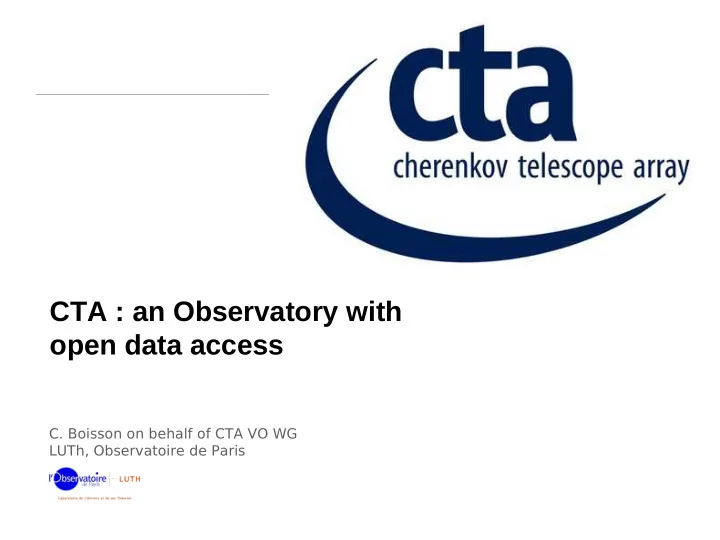

CTA : an Observatory with open data access C. Boisson on behalf of CTA VO WG LUTh, Observatoire de Paris
H.E.S.S. VERITAS MAGIC
@ Kosack 2006
Spectrum and Light Curve: Energy Reconstruction Gamma Rays Which energy? Problem is how to calibrate the detector in energy as atmosphere is part of the detector.
Spectrum and Light Curve: Energy Reconstruction Gamma Rays Which energy? Problem is how to calibrate the detector in energy as atmosphere is part of the detector → simulations are needed for energy reconstruction
Given: Determine physical ▶ (cleaned) image shower parameters: ▶ Impact of the shower in N telescopes parameter/Core ▶ Geometry and location ▶ Depth in pointing direction of telescopes Atmosphere ▶ Current event time ▶ Direction ▶ Energy
Gamma Ray: Hadron: 9
► Simulate processes in atmosphere ► Simulate telescope ► Compare shower images → reconstruct energy → Aharonian et al., 2004, Nature , 432, 75 Resolved extended TeV source Correspond with X-Ray morphology
● First major AGN flare for a source – ● Variability on 5 min (or less) scales Light curves at different timescale from months down to minutes
The “data management” requirements set up a series of possible challenging developments and ICT/e-Science applications in CTA.
@ Kosack 2012
ICTA – Data An observation – instrumental chain Observations are “reconstructed” to get a list of event: e(x,y,Ra,Dec,E,t, ambient conditions) Observing time is not continuous → series of GTI exposures Observation usually sum of 5 to 10hrs on source Reconstructed position of the source → ROI, may be different from pointed Ra, Dec Background(s), image response functions Wide field → more than one source In the field 14
ICTA – Data Products Excess maps Significance maps Exposure maps PSF variation (function of t, E, position across image) Skymaps in different energy bands Integrated spectra Light curves Photometry point when too low statistics 15
CTA – an Observatory CTAO provides archive access DM → full metadata set, complete description of the data Protocols to discover a specific set of data Application to search data and metadata CTA requirement: Science Data Archive interface must be compatible with the Virtual Observatory framework, such that CTA data can be combined with data at other wavelength via a web interface Note: many telescopes → data flow and metadata issues. Complete sampling of waveform event signal would be optimal (scientifically) vs integration (default CTA mode): data rate varies from 0.4 to 5.3 GB/s 16 Reconstructed data / Raw data volume = 20%
CTA – an Observatory Data products Data obtained will be systematically pipeline-processed to generate a range of scientific and auxiliary data products Minimal data product to provide is a list of events with the relevant quality informations, engineering data, required image response functions, as well as science data (images, spectra, light curves) But recall that products are only one representation of the data. One may want to select another set of guess (hadron-gamma separation, bkg,...) 17
VO No standard yet to archive high energy astronomical data SSAP protocol defines a uniform interface to remotely discover and access simple 1-dimensional spectra → OGIP standard PHA format of X-ray spectra not accepted, so difficult fo VHE Spectral Data Model does not describe completely the HE data HE spectra are not physical units but in instrument counts - calibration needed and a model should be assumed to obtain a spectrum in physical units ObsTAP - makes it possible to discover and access the whole dataset of the observation, but doesn’t access the calibration files needed for the analysis Units not adequate (e.g. meter) : problem of precision 18
Topcat
H.E.S.S. AGN Only a few useful hours of data summed over a long time Not pixel but assymetric energy bins Complex info to be stored for high level data to be fully understood
VO No standard yet to archive high energy astronomical data Missing keywords (Utypes) to the Spectral Data Model to describe High Energy astronomical data: e.g. calibration version, model used to extract spectrum, PSF instead of aperture model, time boundaries of observation together with live time Calibration DM : useful for x-calibration, changes flux value but here we have a fully new analysis (bkg, bin sizes, …) Partial data cubes : single exposure data cube access n different observations for better S/N and look to final results Light curves : need to talk to « time series » WG ? Not properly tackled yet. 21
VO – publishing Two kind of data to publish Highest data products and catalogs where modeling is pre-defined just define interface: DataLink? But still need to tell the history of the data set : Provenance ? Some more data with calibrations (on tool side: final post-processing, workflow system rather than a final product) a complete DM We have identified the need of an extension or combination of existent IVOA Data Models such as ObsCore & Characterisation (data products), SimDM & PDL (pipelines), DataLink (protocol), to take account of the particularities of HE Data Products. Provenance is another important block. 22
Provenance Describe the observational path from sky to the dataset Provenance right now too simplifies in ObsTAp Some kind of quality assesment • AmbiantConditions :altitude, weather, wind, pressure versus time, aerosol, moon phase... Create atm. sets ? Keep all metadata? • ObservingConfigurations : How was the telescope configured ? How many telescopes involved ? • DataProcessing : calibration, reconstruction and analysis pipeline Describe the previous steps and acces to « progenitors » if reprocessing of the data is needed Semantics for DataProcessing to be adressed 23
Towards a CTA IVOA Data Model... (1 : A global view) @ Lavalley +
Towards a CTA IVOA Data Model... (2 : ObservingConfiguration)
Towards a CTA IVOA Data Model... (3 : Processing)
In a very near future... → Discuss more, validate suggested DM with IVOA experts → Define a IVOA Data Model for CTA source Catalog : is current IVOA ObsTap enough/suitable ?
Recommend
More recommend